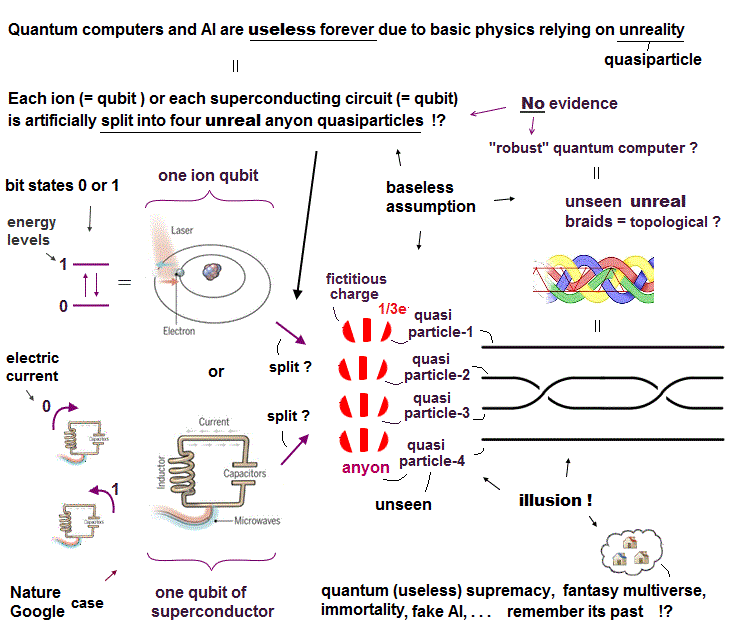
Home page
Microsoft fake quantum computer
Quantum mechanical Hall effect is unreal
(Fig.1) The allegedly fault-tolerant topological quantum computer with fictional quasiparticle qubits with fractional charge is just fiction.

Overhyped media repeatedly says "(illusory) topological quantum computer based on (fictional) Majorana or anyon quasiparticles could be robust or fault-tolerant."
↑ But there is No evidence of robust nor fault-tolerant topological quantum computers, which is just fraud.
First of all, Majorana quasiparticle (or anyon quasiparticle, this introduction-4-5th-paragraphs ) is a fictional particle that does Not exist.
So even one single Majorana qubit has Not been realized ( this 1st-paragraph ).
It is far from millions of qubits required for practical quantum computer.
These fictional Majorana or anyon quasiparticles needed for the still non-existent topological quantum computer are said to have fractional charges unrealistically split from an indivisible electron ( this p.1-figure, this p.29 ).
This 7th-paragraph says -- Unreal quasiparticles
"the motion of electrons and holes can synchronize to behave as a single quasiparticle, in which fragments of the electron appear as if they are physically separated (= impossible, this p.2-2nd-paragraph ). These quasiparticles are sometimes dubbed anyons"
Furthermore, the alleged mechanism of this topologically-protected robust quantum computer based on imaginary (non-existent) braids is so unrealistic that it will never be realized.
(Fig.2) Topological quantum computer full of imaginary concepts such as quasiparticles and unseen braids will never be realized.

They baselessly claim that the (fictional) Majorana or anyon quasiparticles can twist around each other by the unseen (illusory) braids (= nonphysical ) as ( non-existent ) qubits, which virtual worldlines ( this Figure 1 ) would be hard to untie, so "robust" without showing what this 'magical braid' is made of. ← nonsense.
This 10~11th paragraphs insist -- Unreal braids.
"The researchers (unscientifically) liken these qubits to a knot on a shoestring, so that how the knot is tied indicates the information stored"
".. To be clear, No one is tying physical knots in a nanowire (- No physical knots ) — but you can mathematically visualize the timeline of these quasiparticles as you swap their positions as knots or braids. These knots are known as topologically protected states; hence, the proposed quantum computers built with Majorana fermions are known as topological quantum computers."
This 3rd-paragraph says -- Unreal quasiparticle
"The anyons the researchers believe they have created are Not true particles.. Instead anyons are (fictitious) quasiparticles that exist only inside a material."
This p.3-middle-lower says -- Unreal string
"a topological quantum
computer does not seem much like a
computer at all. It works its calculations
on braided strings—but Not physical
strings in the conventional sense (= unreal braids )."
This 3rd-last paragraph says -- Unphysical braids
"The word entanglement suggests that the states of the particles are physically interwoven, braided, or overlapped,.. In actuality, the particles have No physical connection or communication line (= topological braid is illusion )."
This p.1-left says -- Topological = illusion
"Braiding two anyons (= fictitious fractional-charge quasiparticle ) physically by moving one around
the other in real space is theoretically straightforward
but challenging to implement experimentally (= due to lack of reality )."
↑ So neither Majorana quasiparticle nor braid is real ( this p.3-middle-lower ). ← No topological robust quantum computer.
The fictional Majorana quasiparticle itself is impossible to detect or see.
The fictitious fractional-charge anyon or Majorana quasiparticles were said to indirectly appear in some special composite materials as the form of characteristic electric conductance ( this middle = so illusory Majorana quasiparticle means just some electric conductance with zero energy, No real particle, this p.1-intro, this or this middle-Looking for Majoranas in nanowires ) or quantum Hall effect under some electromagnetic fields.
↑ So physicists just observed some special electric conductance (= anyon quasiparticle itself is unobservable ) and falsely claimed they might have detected the sign of (non-existent) fractional-charge anyon quasiparticles, which is Not a legitimate science.
This 12th-paragraph says -- electric conductance = Majorana ?
"When the scientists varied the voltage to their devices, they detected a sudden peak in their electrical conductance . They claimed this electrical signal (= Not fictitious quasiparticle itself ) was evidence of discrete, quantized levels of conductance, a hallmark of Majorana (quasi-)particles"
Actually, Nature journal retracted the dubious research paper of the alleged first discovery of anyon or Majorana quasiparticle by Microsoft.
↑ It is impossible to prove the existence of (imaginary) Majorana quasiparticle just by measuring vague electric conductance.
(Fig.3) Fictional topological quantum computer with imaginary quasiparticles could be simulated by 27 trapped ions ? ← useless, error-prone, far from fault-tolerant.
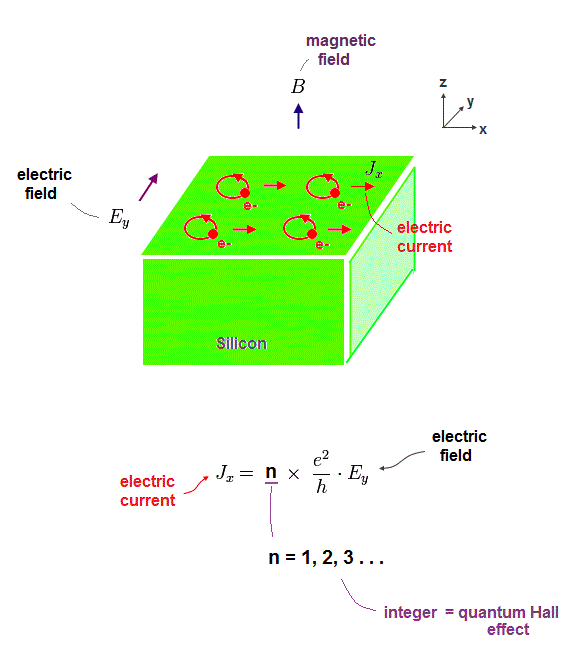
Recently, many media outlets simultaneously reported that the UK-based company Quantinuum and Harvard, Caltech team might have finally created (fictional) quasiparticles called non-abelian anyon with (unreal) fractional-charges that could remember their pasts and potentially enable fault-tolerant robust quantum computer.
↑ Unfortunately, None of these claims are real.
This "Remember the past" means the imaginary braid or knots (= whose knot forms may remain or be 'remembered' ) allegedly created by fictional quasiparticle topological qubits. ← But even one quasiparticle qubit has Not been realized, so No evidence of such quasiparticles remembering the past.
↑ The 3rd, 5th, 10th paragraphs of another news about this same research say
"Vishwanath's team used a powerful machine called a quantum processor to make, a brand-new phase of matter called non-Abelian topological order (= useless concept irrelevant to real world )... the team demonstrated synthesis and control of exotic particles called non-Abelian anyons (= fictional quasiparticle )"
"Non-Abelian anyons, known to physicists as quasi-particles, are only mathematically possible.. The qualifier "quasi" refers to the fact that they are Not exactly particles" ← Anyon or Majorana quasiparticles are Not real particles.
" Quantinuum's newest H2 processor,.. 27 trapped ions." ← Just 27 ion qubits (= one qubit can take only 0 or 1 state ) are far from a practical computer that will need millions of qubits.
Google also conducted the similar research about (fictional) non-Abelian anyon quasiparticles using only 25 superconducting qubits ( this p.7-left-1st-paragraph ) that is still Not a practical computer at all.
↑ Quantinuum and Google tried to express (fictional) anyon quasiparticles by using conventional (= irrelevant ) ion or superconducting qubits, which could Not make real (fault-tolerant) topological quantum computers nor anyon quasiparticle.
The point is neither Quantinuum nor Google achieved real fault-tolerant topological quantum computer with (fictional) anyon quasiparticles, hence, these researches are still useless.
The 7th paragraphs of this or this site say -- Useless fake qubits
"Physicist.. has despaired of the hype and says it's clear to him that neither Quantinuum nor Google has created a topological qubit. It does not take quantum computing to the next level. While Google and Quantinuum demonstrated that their hardware can exhibit several hallmark features of a topological qubit, the components are too fragile to fulfill their intended role in quantum computing" ← useless
The 11th and last paragraphs of this or this site say -- just unreal simulation
"Quantinuum machine does Not truly create nonabelions, but merely simulates some of their properties (= quasiparticle qubit has Not been realized after all, this-9th-paragraph, this 2nd-last-paragraph )"
"it is still unclear how efficient his team’s nonabelions will turn out to be." ← still No evidence of robust nor fault-tolerant quantum computer
The 3rd-last (or 4th-last ) paragraph of this or this says
"because these anyon states are made from conventional, error-prone qubits, No one yet knows whether they can be made stable enough to truly act as topologically protected qubits" ← still error-prone, Not a robust topological quantum computer.
This Quantinuum's 27-ion-qubits showed very bad error rate of 35% (= global fidelity was 0.65, this p.12-A14 ) and the fidelity per qubit was 0.984 (= so each qubit's error rate was 1 - 0.984 = 0.016 = 1.6% ), which is far worse than practically-required error rate of 10-15 ( this 5th-paragraph ).
The error rate of Google's superconducting qubits was also too bad to be a practical computer ( this p.7-left-1st-paragaph showed each two-qubit-gate error rate was 7.3 × 10-3 = 0.73%, which is impractical, too ).
(Fig.4) Fault-tolerant topological quantum computers are fake, overhyped, error-prone.
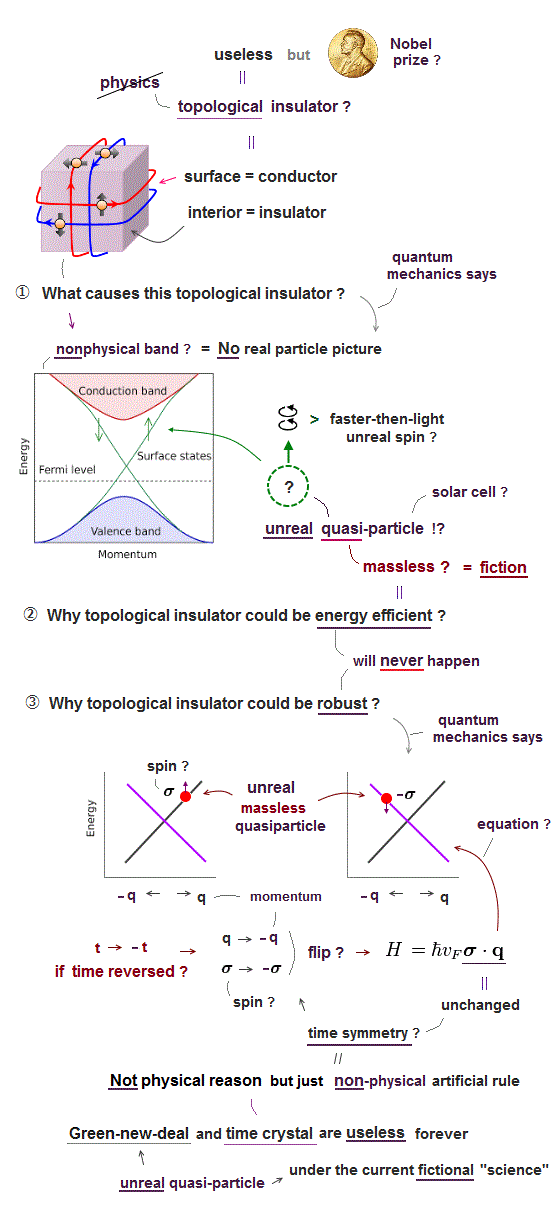
Overhyped topological quantum computers using fictional fractional-charge Majorana or anyon quasiparticles are baselessly said to be fault-tolerant or potentially error-free by using illusory braids.
The recent Microsoft's claim of making the first Majorana qubit turned out to be fraud.
Even the latest Microsoft's research admits there is still No conclusive evidence of this Majorana (quasiparticle) qubit, as this news' insider brief (7/15/2025) says
"the researchers acknowledge that certain non-topological (= Non-Majorana ) systems could mimic the observed signatures."
The 4-5th, 9th paragraphs of this site (7/12/2025) say
"Microsoft's team has built a (= only one ) tetron qubit device (two InAs/Al semiconductor-superconductor nanowires )"
" In a Majorana tetron, four Majorana zero modes encode one qubit (= just one qubit 0 or 1, still Not a computer ).
One way to read the qubit.. the dot's capacitance shifts depending on whether the nanowire's electron parity is 0 or 1 (even or odd total electrons)"
"By contrast, the Pauli-X (X loop) measurement had a ~84% fidelity (~16% chance of misidentifying the parity). This relatively high error rate"
↑ So even in this latest research, Microsoft just measured just one impractical pseudo-Majorana qubit as electric capacitance (= still No evidence of Majorana quasiparticle, this-p.2-right-2nd-paragraph, p.7-left-3rd-paragraph ) with too high error rate of 16% (= this-p.1-abstract ), far from fault-tolerant or error-free ( this-2nd-paragraph ).
This-3rd-last-paragraph says
"If the measurement-based approach can be scaled up and the X loop error rate lowered, the odds will (= still unrealized, impractical, contrary to hypes ) improve.."
This news' middle-challenges and future directions (7/16/2025) say
"The measurement errors,.. would need to be reduced by several orders of magnitude for practical quantum computation...
The 16% error rate for X measurements is particularly concerning" ← far from the hyped fault tolerant topological quantum computer
"Another challenge is scaling up from a single tetron to... building networks of thousands or millions of tetron qubits will require solving complex problem" ← still only one error-prone useless qubit (= fake Majorana ), still Not a computer.
The 4th paragraph of this hyped news (7/14/2025) says
"This is really the first step toward (= still unrealized ) universal topological quantum computing, or fault-tolerant computing" ← hype
↑ This research paper ↓
p.4-right-2nd-paragraph says "the 27-qubit IBM Falcon processor (= this is superconducting qubits or fake anyon qubits )...
experimental state yields a
fidelity of 0.87 (= error rate is 13%, far from fault tolerant ) to the ideal state."
p.6-right-last says "the 9
qubits (= just 9 bitstring, still Not a computer ) participating"
Fig.4(i) shows this 9-qubit error rate was very bad = 10 ~ 70 %
p.7-right-Discussion says "The success in this new pursuit of quantum advantage will (= still unrealized ) hinge on solving two open problems. Firstly, noise in sampling must be countered." ← still noisy = error-prone, far from fault-tolerant topological or (fictional) anyon quasiparticle qubits, contrary to the hyped news.
(Fig.F) Useless quantum mechanical unreal quasiparticle model with fractional-charges needs overhyped fake news or targets = illusory quantum computers.
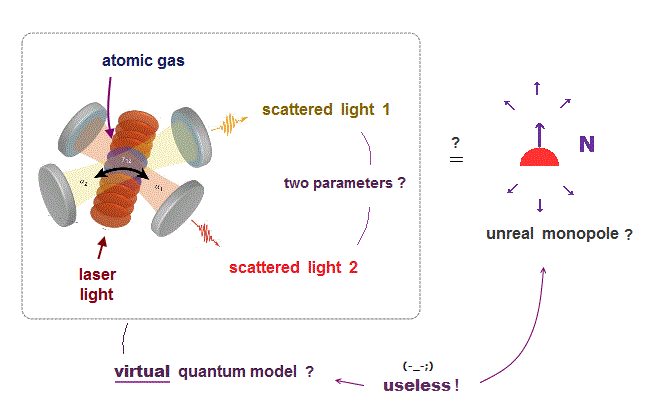
The 1st, 3rd, 15-16th, 11th-last paragraphs of this overhyped news (7/21/2025) say
"When researchers cooled a precisely stacked film of graphene to near absolute zero (= impractically-low temperature, useless device ), they watched electrons glide around its perimeter as if they carried only fragments of their usual charge (= fictional quasiparticles with fractional-charges, this-2nd-paragraph )." ← impossible
" suggests a path toward computers that sip rather than guzzle power." ← hype, fake news
"Picture a river of fractional charges (= unreal model ) meandering"
"If the fractional quantum anomalous Hall effect is combined with a superconductor, the resulting quantum computer will (= just speculation, still useless ) be more efficient than current quantum computers and free of error," ← overhype.
"Fractional quantum anomalous Hall states already satisfy key topological criteria, supporting anyon‑like quasiparticles (= unreal )"
↑ This research paper's ( this-last, this )-p.1-abstract says nothing about any practical application nor hyped quantum computers (= so useless quantum mechanical research ), contrary to the above fake news.
↑ This research just measured electric conductance or resistance (= Rxx, Rxy ) of graphene under impractically-low temperature (= 400mK ) in amomalous Hall effect ( this-p.4-Fig.1~p.10-Fig.4 ) caused by classical Lonrentz magnetic force irrelevant to quantum mechanical illusory fractional-charge quasiparticles.
(Fig.N) Quantum computers are useless forever, based on fictional quasiparticles (= anyon ) with fractional charges.
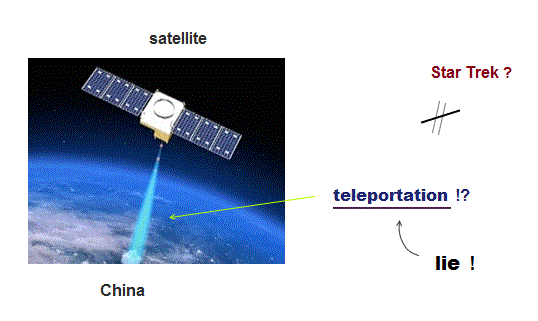
The 1st, 6th, 7th, last paragraphs of this or this hyped news (8/5/2025) say
"But today's machines are notoriously fragile. The quantum bits, or "qubits," that store and process information are easily disrupted by their environment, leading to errors that quickly accumulate." ← Quantum computers are useless, too error-prone to give right answers.
"By adding a single new type of anyon (= fictional quasiparticle with fractional charge, this-2nd-paragraph ), which was previously discarded in traditional approaches to topological quantum computation, the team shows that Ising anyons can be made universal, capable of performing any quantum computation through braiding alone." ← fake news"The team dubbed these rescued particles neglectons" ← This research is too unrealistic for me to neglect in 'this week overhyped fake news'.
"If experimentalists can find a way to realize this extra stationary anyon," ← It means still No experiments finding this fictional anyon quasiparticle have been performed.
This news on the same anyon research (= lower challenges and outlook ) says
"The researchers emphasize that their idea is currently theoretical (= this new anyon quasiparticle is still pie-in-the-sky theory with No experimental realization ),...
".. The biggest challenge now is to find a material capable of supporting a stationary neglecton."
↑ So this hyped new anyon quasiparticle called neglecton allegedly leading to the universal quantum computers is just fiction with No experimental confirmation.
↑ this-research paper's p.6-8-methods show just unphysical theory with No experimental procedure.
Only an integral times electric charge (= e- ) can be observed due to an unbreakable electron and proton ( this-2nd-paragraph ).
We can Not detect any real particle's fractional charges, as shown in the unseen (imaginary) quarks with fractional charges.
So the paradoxical quasiparticles with fractional charges are fake, just imaginary non-existent particles ( This-the science, this-1st-paragraph ).
This-p.2-left-last-paragraph says -- Unreal fractional charge
"Tsui made it also clear that it was Not really the electron charge that changed; rather, the charge of the excitation emerging from the interactions among the electrons
was a fraction of the electron charge: "The electron entity
has still the same charge. All the electrons move together
in this quantum fluid in a correlated manner and the smallest excitation carries a charge that is a third of the electron
charge. It does Not mean that the individual electrons carry a
third of the charge"
↑ Unreal contradictory fractional charges.
This-2nd-paragraph says -- An indivisible electron
"To be clear, the researchers are not saying that the electron can be broken apart. Electrons are elementary particles, indivisible and unbreakable. "

Feel free to link to this site.